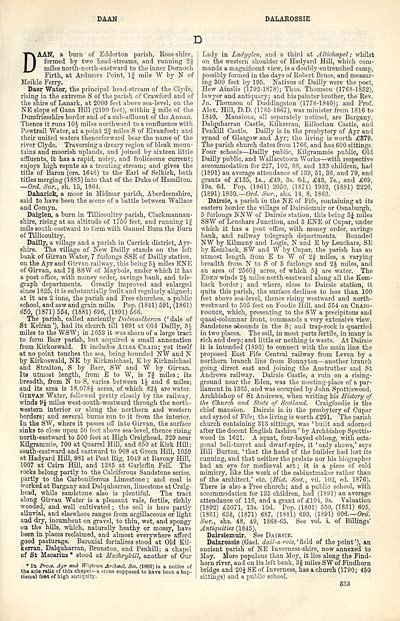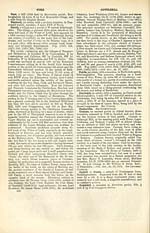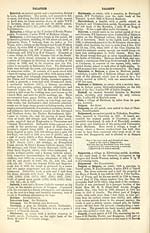Ordnance gazetteer of Scotland
(341) Page 333
Download files
Complete book:
Individual page:
Thumbnail gallery: Grid view | List view

DAAN
DALAROSSIE
D
DA ATT, a burn of Edderton parish, Ross-shire,
formed by two head-streams, and running 2§
miles north-north-eastward to the inner Dornoch
Firth, at Ardmore Point, If mile W by N of
Meikle Ferry.
Daer Water, the principal head-stream of the Clyde,
rising in the extreme S of the parish of Crawford and of
the snire of Lanark, at 2000 feet above sea-level, on the
NE slope of Gana Hill (2190 feet), within J mile of the
Dumfriesshire border and of a sub-affluent of the Annan.
Thence it runs 10J miles northward to a confluence with
Powtrail Water, at a point 2| miles S of Elvanfoot; and
their united waters thenceforward bear the name of the
river Clyde. Traversing a dreary region of bleak moun-
tains and moorish uplands, and joined by sixteen little
affluents, it has a rapid, noisy, and frolicsome current;
enjoys high repute as a trouting stream ; and gives the
title of Baron (ere. 1646) to the Earl of Selkirk, both
titles merging (1885) into that of the Duke of Hamilton.
— Ord. JSur., sh. 15, 1864.
Daharick, a moor in Midmar parish, Aberdeenshire,
said to have been the scene of a battle between Wallace
and Comyn.
Daiglen, a burn in Tillicoultry parish, Clackmannan-
shire, rising at an altitude of 1750 feet, and running If
mile south-eastward to form with Gannel Burn the Burn
of Tillicoultry.
Dailly, a village and a parish in Carrick district, Ayr-
shire. The village of New Dailly stands on the left
bank of Girvan Water, 7 furlongs SSE of Dailly station,
on the Ayr and Girvan railway, this being 5J miles ENE
of Girvan, and 7§ SSW of Maybole, under which it has
a post office, with money order, savings bank, and tele-
graph departments. Greatly improved and enlarged
since 1825, it is substantially built and regularly aligned;
at it are 2 inns, the parish and Free churches, a public
school, and saw and grain mills. Pop. (1841) 591, (1861)
650, (1871) 554, (1881) 696, (1891) 566.
The parish, called anciently Dalmaolkeran ( ' dale of
St Eeiran'), had its church till 1691 at Old Dailly, Z\
miles to the WSW; in 1653 it was shorn of a large tract
to form Barr parish, but acquired a small annexation
from Kirkoswald. It includes Ailsa Craig; yet itself
at no point touches the sea, being bounded NW and N
by Kirkoswald, NE by Kirkmichael, E by Kirkmichael
and Straiton, S by Barr, SW and W by Girvan.
Its utmost length, from E to W, is 7| miles ; its
breadth, from N to S, varies between 1J and 6 miles;
and its area is 18,078J acres, of which 82^ are water.
Girvan Water, followed pretty closely by the railway,
winds 9J miles west-south-westward through the north-
western interior or along the northern and western
borders; and several burns run to it from the interior.
In the SW, where it passes off into Girvan, the surface
sinks to close upon 50 feet above sea-level, thence rising
north-eastward to 500 feet at High Craighead, 329 near
Kilgrammie, 700 at Quarrel Hill, and 850 at Kirk Hill;
south-eastward and eastward to 908 at Green Hill, 1059
at Hadyard Hill, 981 at Peat Rig, 1049 at Barony Hill,
1007 at Cairn Hill, and 1385 at Garleffin Fell. The
rooks belong partly to the Calciferous Sandstone series,
partly to the Carboniferous Limestone ; and coal is
worked at Bargany and Dalquharran, limestone at Craig-
head, while sandstone also is plentiful. The tract
~ Girvan Water is a pleasant vale, fertile, richly
along
wooded, and well cultivated ; the soil is here partly
alluvial, and elsewhere ranges from argillaceous or light
and dry, incumbent on gravel, to thin, wet, and spongy
on the hills, which, naturally heathy or mossy, have
been in places reclaimed, and almost everywhere afford
good pasturage. Baronial fortalices stood at Old Kil-
kercan, Dalquharran, Brunston, and Penkill; a chapel
of St Maoarius * stood at Machrykill, another of Our
* In Procs. Ayr and Wigtown Archaol. Soc. (1882) is a notice of
the sole relic of this chapel— a stone supposed to have heen a bap-
tismal font of high antiquity.
Lady in Lady glen, and a third at Altichapel ; whilst
on the western shoulder of Hadyard Hill, which com-
mands a magnificent view, is a doubly-entrenched camp,
possibly formed in the days of Robert Bruce, and measur-
ing 300 feet by 195. Natives of Dailly were the poet,
Hew Ainslie (1792-1878); Thos. Thomson (1768-1852),
lawyer and antiquary ; and his painter brother, the Rev.
Jn. Thomson of Duddingston (1778-1840); and Prof.
Alex. Hill, D.D. (1785-1867), was minister from 1816 to
1840. Mansions, all separately noticed, are Bargany,
Dalquharran Castle, Kilkerran, Killochan Castle, and
Penkill Castle. Dailly is in the presbytery of Ayr and
synod of Glasgow and Ayr; the living is worth £379.
The parish church dates from 1766, and has 600 sittings.
Four schools — Dailly public, Kilgrammie public, Old
Dailly public, and Wallacetown Works — with respective
accommodation for 227, 102, 88, and 133 children, had
(1891) an average attendance of 139, 51, 36, and 79, and
grants of £135, Is., £49, 3s. 6d., £43, 7s., and £69,
19s. 6d. Pop. (1861) 2050, (1871) 1932, (1881) 2226,
(1891) 1830.— Ord. Sur., shs. 14, 8, 1863.
Dairsie, a parish in the NE of Fife, containing at its
eastern border the village of Dairsiemuir or Osnaburgh,
5 furlongs MW of Dairsie station, this being 3| miles
SSW of Leuchars Junction, and 3 ENE of Cupar, under
which it has a post office, with money order, savings
bank, and railway telegraph departments. Bounded
NW by Kilmany and Logie, N and E by Leuchars, SE
by Kemback, SW and W by Cupar, the parish has an
utmost length from E to W of 2% miles, a varying
breadth from N to S of 5 furlongs and 2| miles, and
an area of 2560J acres, of which 5J are water. The
Eden winds 2J miles north-eastward along all the Kem-
back border ; and where, close to Dairsie station, it
quits this parish, the surface declines to less than 100
feet above sea-level, thence rising westward and north-
westward to 505 feet on Foodie Hill, and 554 on Craig-
foodie, which, presenting to the SW a precipitous and
quasi-columnar front, commands a very extensive view.
Sandstone abounds in the S ; and trap-rock is quarried
in two places. The soil, in most parts fertile, in many is
rich and deep; and little or nothing is waste. At Dairsie
it is intended (1893) to connect with the main line the
proposed East Fife Central railway from Leven by a
northern branch line from Bonnyton — another branch
going direct east and joining the Anstruther and St
Andrews railway. Dairsie Castle, a ruin on a rising-
ground near the Eden, was the meeting-place of a par-
liament in 1335, and was occupied by John Spottiswood,
Archbishop of St Andrews, when writing his History of
the Church and State of Scotland. Craigfoodie is the
chief mansion. Dairsie is. in the presbytery of Cupar
and synod of Fife; the living is worth £291. The parish
church containing 313 sittings, was ' built and adorned
after the decent English fashion ' by Archbishop Spottis-
wood in 1621. A squat, four-bayed oblong, with octa-
gonal bell- turret and dwarf-spire, it ' only shows, ' says
Hill Burton, ' that the hand of the builder had lost its
cunning, and that neither the prelate nor his biographer
had an eye for mediaeval art ; it is a piece of cold
mimicry, like the work of the cabinetmaker rather than
of the architect,' etc. {Mist. Scot., vii. 102, ed. 1876).
There is also a Free church; and a public school, with
accommodation for 135 children, had (1891) an average
attendance of 116, and a grant of £104, 9s. Valuation
(1892) £5071, 13s. lOd. Pop. (1801) 550, (1831) 605,
(1861) 638, (1871) 687, (1881) 693, (1891) 606.— Ord.
Sur., shs. 48, 49, 1868-65. See vol. i. of Billings'
Antiquities (1845).
Dairsiemuir. See Dairsie.
Dalarossie (Gael, dail-a-rois, ' field of the point '), an
ancient parish of NE Inverness-shire, now annexed to
Moy. More populous than Moy, it lies along the Find-
horn river, and on its left bank, 3| miles SW of Findhorn
bridge and 20| SE of Inverness, has a church (1790; 450
sittings) and a public school.
333
DALAROSSIE
D
DA ATT, a burn of Edderton parish, Ross-shire,
formed by two head-streams, and running 2§
miles north-north-eastward to the inner Dornoch
Firth, at Ardmore Point, If mile W by N of
Meikle Ferry.
Daer Water, the principal head-stream of the Clyde,
rising in the extreme S of the parish of Crawford and of
the snire of Lanark, at 2000 feet above sea-level, on the
NE slope of Gana Hill (2190 feet), within J mile of the
Dumfriesshire border and of a sub-affluent of the Annan.
Thence it runs 10J miles northward to a confluence with
Powtrail Water, at a point 2| miles S of Elvanfoot; and
their united waters thenceforward bear the name of the
river Clyde. Traversing a dreary region of bleak moun-
tains and moorish uplands, and joined by sixteen little
affluents, it has a rapid, noisy, and frolicsome current;
enjoys high repute as a trouting stream ; and gives the
title of Baron (ere. 1646) to the Earl of Selkirk, both
titles merging (1885) into that of the Duke of Hamilton.
— Ord. JSur., sh. 15, 1864.
Daharick, a moor in Midmar parish, Aberdeenshire,
said to have been the scene of a battle between Wallace
and Comyn.
Daiglen, a burn in Tillicoultry parish, Clackmannan-
shire, rising at an altitude of 1750 feet, and running If
mile south-eastward to form with Gannel Burn the Burn
of Tillicoultry.
Dailly, a village and a parish in Carrick district, Ayr-
shire. The village of New Dailly stands on the left
bank of Girvan Water, 7 furlongs SSE of Dailly station,
on the Ayr and Girvan railway, this being 5J miles ENE
of Girvan, and 7§ SSW of Maybole, under which it has
a post office, with money order, savings bank, and tele-
graph departments. Greatly improved and enlarged
since 1825, it is substantially built and regularly aligned;
at it are 2 inns, the parish and Free churches, a public
school, and saw and grain mills. Pop. (1841) 591, (1861)
650, (1871) 554, (1881) 696, (1891) 566.
The parish, called anciently Dalmaolkeran ( ' dale of
St Eeiran'), had its church till 1691 at Old Dailly, Z\
miles to the WSW; in 1653 it was shorn of a large tract
to form Barr parish, but acquired a small annexation
from Kirkoswald. It includes Ailsa Craig; yet itself
at no point touches the sea, being bounded NW and N
by Kirkoswald, NE by Kirkmichael, E by Kirkmichael
and Straiton, S by Barr, SW and W by Girvan.
Its utmost length, from E to W, is 7| miles ; its
breadth, from N to S, varies between 1J and 6 miles;
and its area is 18,078J acres, of which 82^ are water.
Girvan Water, followed pretty closely by the railway,
winds 9J miles west-south-westward through the north-
western interior or along the northern and western
borders; and several burns run to it from the interior.
In the SW, where it passes off into Girvan, the surface
sinks to close upon 50 feet above sea-level, thence rising
north-eastward to 500 feet at High Craighead, 329 near
Kilgrammie, 700 at Quarrel Hill, and 850 at Kirk Hill;
south-eastward and eastward to 908 at Green Hill, 1059
at Hadyard Hill, 981 at Peat Rig, 1049 at Barony Hill,
1007 at Cairn Hill, and 1385 at Garleffin Fell. The
rooks belong partly to the Calciferous Sandstone series,
partly to the Carboniferous Limestone ; and coal is
worked at Bargany and Dalquharran, limestone at Craig-
head, while sandstone also is plentiful. The tract
~ Girvan Water is a pleasant vale, fertile, richly
along
wooded, and well cultivated ; the soil is here partly
alluvial, and elsewhere ranges from argillaceous or light
and dry, incumbent on gravel, to thin, wet, and spongy
on the hills, which, naturally heathy or mossy, have
been in places reclaimed, and almost everywhere afford
good pasturage. Baronial fortalices stood at Old Kil-
kercan, Dalquharran, Brunston, and Penkill; a chapel
of St Maoarius * stood at Machrykill, another of Our
* In Procs. Ayr and Wigtown Archaol. Soc. (1882) is a notice of
the sole relic of this chapel— a stone supposed to have heen a bap-
tismal font of high antiquity.
Lady in Lady glen, and a third at Altichapel ; whilst
on the western shoulder of Hadyard Hill, which com-
mands a magnificent view, is a doubly-entrenched camp,
possibly formed in the days of Robert Bruce, and measur-
ing 300 feet by 195. Natives of Dailly were the poet,
Hew Ainslie (1792-1878); Thos. Thomson (1768-1852),
lawyer and antiquary ; and his painter brother, the Rev.
Jn. Thomson of Duddingston (1778-1840); and Prof.
Alex. Hill, D.D. (1785-1867), was minister from 1816 to
1840. Mansions, all separately noticed, are Bargany,
Dalquharran Castle, Kilkerran, Killochan Castle, and
Penkill Castle. Dailly is in the presbytery of Ayr and
synod of Glasgow and Ayr; the living is worth £379.
The parish church dates from 1766, and has 600 sittings.
Four schools — Dailly public, Kilgrammie public, Old
Dailly public, and Wallacetown Works — with respective
accommodation for 227, 102, 88, and 133 children, had
(1891) an average attendance of 139, 51, 36, and 79, and
grants of £135, Is., £49, 3s. 6d., £43, 7s., and £69,
19s. 6d. Pop. (1861) 2050, (1871) 1932, (1881) 2226,
(1891) 1830.— Ord. Sur., shs. 14, 8, 1863.
Dairsie, a parish in the NE of Fife, containing at its
eastern border the village of Dairsiemuir or Osnaburgh,
5 furlongs MW of Dairsie station, this being 3| miles
SSW of Leuchars Junction, and 3 ENE of Cupar, under
which it has a post office, with money order, savings
bank, and railway telegraph departments. Bounded
NW by Kilmany and Logie, N and E by Leuchars, SE
by Kemback, SW and W by Cupar, the parish has an
utmost length from E to W of 2% miles, a varying
breadth from N to S of 5 furlongs and 2| miles, and
an area of 2560J acres, of which 5J are water. The
Eden winds 2J miles north-eastward along all the Kem-
back border ; and where, close to Dairsie station, it
quits this parish, the surface declines to less than 100
feet above sea-level, thence rising westward and north-
westward to 505 feet on Foodie Hill, and 554 on Craig-
foodie, which, presenting to the SW a precipitous and
quasi-columnar front, commands a very extensive view.
Sandstone abounds in the S ; and trap-rock is quarried
in two places. The soil, in most parts fertile, in many is
rich and deep; and little or nothing is waste. At Dairsie
it is intended (1893) to connect with the main line the
proposed East Fife Central railway from Leven by a
northern branch line from Bonnyton — another branch
going direct east and joining the Anstruther and St
Andrews railway. Dairsie Castle, a ruin on a rising-
ground near the Eden, was the meeting-place of a par-
liament in 1335, and was occupied by John Spottiswood,
Archbishop of St Andrews, when writing his History of
the Church and State of Scotland. Craigfoodie is the
chief mansion. Dairsie is. in the presbytery of Cupar
and synod of Fife; the living is worth £291. The parish
church containing 313 sittings, was ' built and adorned
after the decent English fashion ' by Archbishop Spottis-
wood in 1621. A squat, four-bayed oblong, with octa-
gonal bell- turret and dwarf-spire, it ' only shows, ' says
Hill Burton, ' that the hand of the builder had lost its
cunning, and that neither the prelate nor his biographer
had an eye for mediaeval art ; it is a piece of cold
mimicry, like the work of the cabinetmaker rather than
of the architect,' etc. {Mist. Scot., vii. 102, ed. 1876).
There is also a Free church; and a public school, with
accommodation for 135 children, had (1891) an average
attendance of 116, and a grant of £104, 9s. Valuation
(1892) £5071, 13s. lOd. Pop. (1801) 550, (1831) 605,
(1861) 638, (1871) 687, (1881) 693, (1891) 606.— Ord.
Sur., shs. 48, 49, 1868-65. See vol. i. of Billings'
Antiquities (1845).
Dairsiemuir. See Dairsie.
Dalarossie (Gael, dail-a-rois, ' field of the point '), an
ancient parish of NE Inverness-shire, now annexed to
Moy. More populous than Moy, it lies along the Find-
horn river, and on its left bank, 3| miles SW of Findhorn
bridge and 20| SE of Inverness, has a church (1790; 450
sittings) and a public school.
333
Set display mode to: Large image | Transcription
Images and transcriptions on this page, including medium image downloads, may be used under the Creative Commons Attribution 4.0 International Licence unless otherwise stated. ![]()
| Gazetteers of Scotland, 1803-1901 > Ordnance gazetteer of Scotland > (341) Page 333 |
|---|
| Permanent URL | https://digital.nls.uk/97397338 |
|---|

